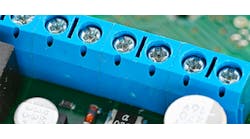DAVID EMORY
Director, End User Sales,
B&R Industrial Automation
The adaptive-machine concept certainly isn’t new, but it’s expanding to encompass even more technology. The entire idea is moving more toward adaptive manufacturing. The ACOPOS 6D is an important part of that expansion. Practical interest is growing in the need for the technology in verticals such as medical-device assembly, food and beverage, consumer products and cosmetics—anywhere you find the need for a compact, flexible layout for the manufacturing process. Compared to a standard servo drive and motor, think of an ACOPOS 6D segment like the drive and the motor stator all built into one package. If you are familiar with ACOPOSTrak, this is essentially the same as a Trak segment, which measures 240 mm by 240 mm by 70 mm and can be air-cooled, but is also already set up to be liquidcooled if necessary. Each segment is supplied with 48-60 Vdc. The segments can be combined in any configuration. The only real restriction is that one of the full edges of a segment must be adjacent to a full edge of another segment.
David Emory, director of end user sales at B&R Industrial Automation, answers several questions that address the advantages of the ACOPOS 6D.
The modularity of ACOPOS 6D allows for reconfiguration to add, remove or reposition segments later.
Q: The adaptive-machine concept has evolved into adaptive manufacturing. How does the ACOPOS 6D fit into that concept and evolution?
A: The adaptive machine is the next generation of manufacturing platforms. They make use of enabling technologies like magnetic transport systems, such as ACOPOS 6D, ACOPOStrak, and SuperTrak, robotics, vision and smart sensors in close coordination to maximize the flexibility and longevity of the system. These technologies “bake in” the capacity for quick changeover and batch-size-one production capabilities. The adaptive machine can be re-tooled and re-purposed as fast as product variants change for better utilization from a financial and engineering level.
Q: What is the advantage of modularizing the ACOPOS 6D into segments?
A: The modular design of ACOPOS 6D segments give us the design flexibility to match the functional needs of a system with the space constraints that are always present on the manufacturing floor. It also allows for reconfiguration to add, remove or reposition segments later on to fit additional equipment or process steps or an optimization to product flow.
Q: What types of applications does the ACOPOS 6D enable?
A: The ACOPOS 6D is the backbone for almost any adaptive machine. The 6 degrees of freedom that each shuttle can move through opens a wide range of use cases. To name a few, the ACOPOS 6D is well-served in pick and place, dispensing, process to process transport, batching, collating, filling, labeling, capping and assembly. This list is by no means exhaustive as our customers are only just scratching the surface of its capabilities.
For more information, visit www.br-automation.com




